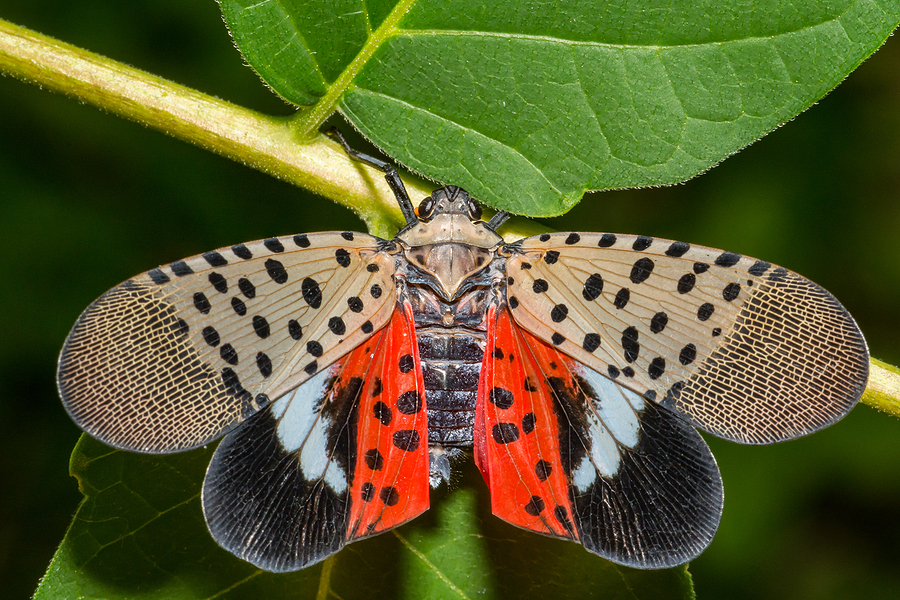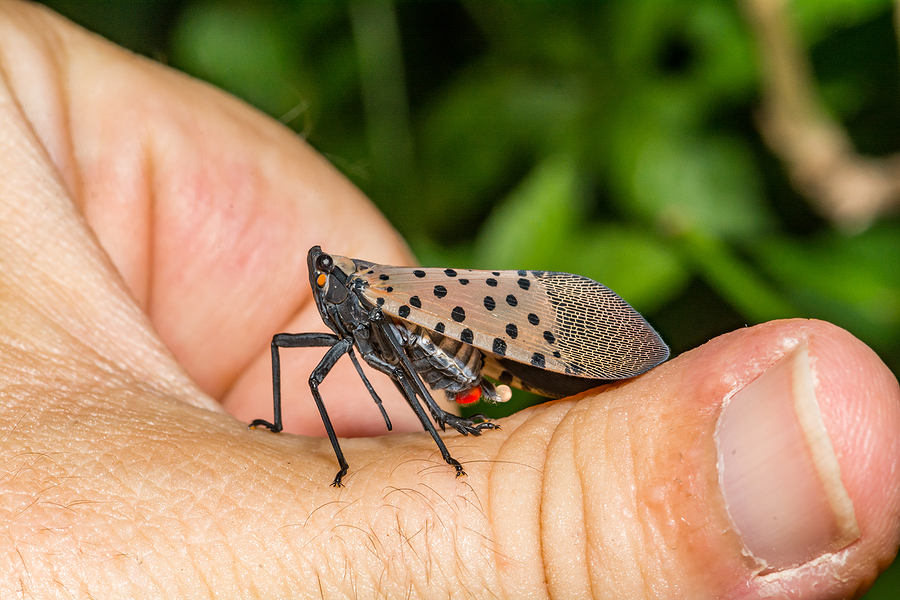Spotted Lanternfly (SLF): A Highly Invasive Threat to Agriculture and Ecosystems
The Spotted Lanternfly (Lycorma delicatula), a native of Asia, has emerged as a highly invasive insect with the potential to wreak havoc on agricultural crops and native ecosystems here in North America. This planthopper was first discovered in southeastern Pennsylvania in 2014, where it was found feeding on a Tree of Heaven (Ailanthus altissima). The initial introduction of SLF to the region is believed to have occurred in 2012, most likely through egg masses hitchhiking on stone shipments near Philadelphia. Since then, this destructive insect has rapidly spread to 11 states as of January 3, 2022.

Identification of Spotted Lanternfly
Adult SLF are visually striking, measuring approximately one inch long and one-half inch wide. The front wings display a gray color adorned with black spots, while the hind wings exhibit striking shades of red, black, and white. Its head and legs are black, and the abdomen is characterized by broad black bands against a yellow backdrop. The SLF life cycle comprises four nymphal stages, an adult stage, and overwintering as egg masses. Adults are typically present from July until the first frost. Recognizing egg masses is crucial for early detection; they are about one inch long and resemble a glossy smear of mud, often found on various surfaces like trees, rusty metal, plastic yard objects, cars, and trailers.
Rapid Dispersal Mechanism
SLF has demonstrated an impressive ability to move considerable distances through various means. On their own, these insects can travel 3 to 4 miles by walking, jumping, and flying. However, their widespread dispersion is primarily facilitated by hitchhiking at all life stages. Nymphs and adults have been known to fly into open windows or the back of trucks, while egg masses can be found on a myriad of outdoor surfaces.
SLF Invasion in Ohio
In Ohio, SLF was first detected and established in Mingo Junction in October 2020. Subsequently, several populations were found in Cuyahoga County in September 2021. In response to the threat posed by this invasive species, the Ohio Department of Agriculture (ODA) has implemented a quarantine for the affected counties of Jefferson and Cuyahoga.
Impact and Concerns
The SLF’s primary mode of feeding is by extracting sugary sap from woody plants using a piercing-sucking mouthpart, akin to a straw. Although adults primarily target the Tree of Heaven, they have demonstrated a voracious appetite and have been found feeding on over 100 different plant species, including grapes, black walnut, maples, willow, river birch, black cherry, tulip poplar, and some fruit trees. The consequences of large SLF populations can be severe, leading to weeping wounds on plants and increasing their vulnerability to canopy dieback, pests, and diseases. Consequently, the viticulture, tree fruit, nursery, and timber industries face significant threats from this invasive pest.
Apart from the agricultural impacts, SLF’s proliferation can also cause nuisance problems. The insects excrete excessive sugar-water or honeydew, leading to the formation of sooty mold fungi, which can damage plants and cover outside surfaces. This attraction to sweetness also draws bees and wasps, elevating the risk of stings and posing safety concerns for humans.
The Role of Cleveland Metroparks
In the battle against SLF, early detection is key to safeguarding natural resources. Cleveland Metroparks has been actively involved in conducting surveys since 2020 to identify locations of Tree of Heaven and to spot potential SLF infestations.

How Can the Public Help?
Individuals can play an essential role in monitoring and reporting SLF populations. Downloading the Great Lakes Early Detection (GLEDN) application, available on both iOS and Android, allows people to document populations of Tree-of-Heaven and contribute to early detection efforts. The OSU extension Webinar link provides valuable insights into using the GLEDN app effectively.
Report Suspected SLF Infestations
If anyone suspects a spotted lanternfly infestation at any life stage, it is important to take a picture or collect a sample and report the finding to the ODA Plant Pest Control form. Reports can be sent to plantpest@agri.ohio.gov or call 614-728-6400.
By remaining vigilant and actively participating in the fight against the Spotted Lanternfly, communities can protect their valuable crops, natural habitats, and quality of life from the threats posed by this highly invasive insect. We enjoy sharing information like this to help spread the word about news that impacts our environment. Keep the good word going and share this post with a friend!
Contact Us

